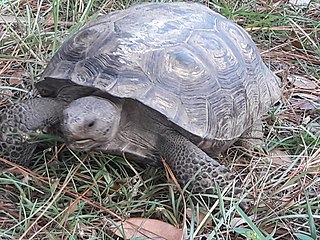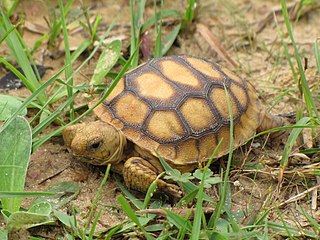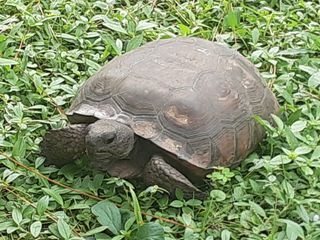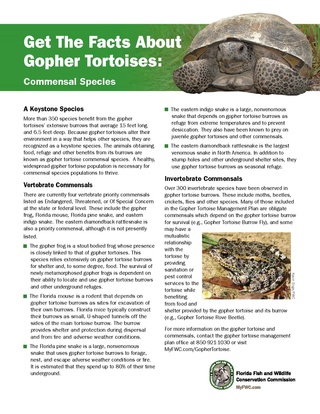Gopher Tortoise: Difference between revisions
mNo edit summary |
mNo edit summary |
||
| (5 intermediate revisions by the same user not shown) | |||
| Line 1: | Line 1: | ||
<div class="irlbody"> | <div class="irlbody"> | ||
{{IRL header estuary|cat=Biota}} | {{IRL header estuary|cat=Biota}} | ||
<div class="irlcontenttop"> | <div class="irlcontenttop"> | ||
[[File:Florida gopher tortoise.jpg|320px|thumb|alt=Florida Gopher Tortoise in Melbourne, FL|'''Gopher tortoise'''<br/> ''Gopherus polyphemus''<br/>Status: [[:Category:Endangered Species|State Threatened]]]] | |||
The gopher tortoise (''Gopherus polyphemus'') is one of five North American tortoise species and is the only tortoise naturally found east of the Mississippi River. Its range includes the southeastern Coastal Plain from southeastern Louisiana east to southern South Carolina, and south to Florida. Gopher tortoises occur in parts of all 67 Florida counties.<ref name=fwcgopher /> The gopher tortoise is a keystone species to more than 350 other species that inhabit the burrows they dig. | |||
[[File:Florida gopher tortoise.jpg|320px| | |||
The gopher tortoise (''Gopherus polyphemus'') is one of five North American tortoise species and is the only tortoise naturally found east of the Mississippi River. | |||
Its range includes the southeastern Coastal Plain from southeastern Louisiana east to southern South Carolina, and south to Florida. Gopher tortoises occur in parts of all 67 Florida counties.<ref name=fwcgopher /> | |||
The gopher tortoise is unique in that it is Federally listed as Threatened under the Endangered Species Act, but only west of the Mobile and Tombigbee Rivers in Alabama (U.S. Fish and Wildlife Service 1987). In the eastern portion of its range, the gopher tortoise is a Candidate species for federal protection (U.S. Fish and Wildlife Service 2011).<ref name=fwsgopher /> The gopher tortoise has some form of state-level protection in each state which it occurs and is a State-designated Threatened species in Florida.<ref name=fl68a /> | The gopher tortoise is unique in that it is Federally listed as Threatened under the Endangered Species Act, but only west of the Mobile and Tombigbee Rivers in Alabama (U.S. Fish and Wildlife Service 1987). In the eastern portion of its range, the gopher tortoise is a Candidate species for federal protection (U.S. Fish and Wildlife Service 2011).<ref name=fwsgopher /> The gopher tortoise has some form of state-level protection in each state which it occurs and is a State-designated Threatened species in Florida.<ref name=fl68a /> | ||
</div> | </div> | ||
<div class="irlcontentmiddle"> | <div class="irlcontentmiddle"> | ||
==Appearance== | ==Appearance== | ||
[[File:Baby Gopher Tortoise (5960562387).jpg|320px| | [[File:Baby Gopher Tortoise (5960562387).jpg|320px|thumb|alt=Baby Gopher Tortoise|Baby Gopher Tortoise]] | ||
The gopher tortoise is a moderate-sized, terrestrial turtle, averaging 9–11 inches in length when fully grown, though it can reach lengths of up to 15 inches.<ref name=ernst /> The species is identifiable by its stumpy, elephantine hind feet and flattened, shovel-like forelimbs covered in thick scales. | The gopher tortoise is a moderate-sized, terrestrial turtle, averaging 9–11 inches in length when fully grown, though it can reach lengths of up to 15 inches.<ref name=ernst /> The species is identifiable by its stumpy, elephantine hind feet and flattened, shovel-like forelimbs covered in thick scales. | ||
| Line 23: | Line 17: | ||
==Behavior== | ==Behavior== | ||
[[File:Gopher tortoise 003.jpg|320px| | [[File:Gopher tortoise 003.jpg|320px|thumb|alt=Florida Gopher Tortoise|Florida Gopher Tortoise]] | ||
Gopher tortoises can live 40 to 60 years in the wild, though captive tortoises may live 90+ years. Males reach adulthood at approximately 9-12 years of age, whereas a female may take 10-21 years to reach maturity depending on local resource abundance and latitude.<ref name=ernst /> The breeding season occurs between March and October. Females typically lay one clutch of 5-9 ping pong ball-sized eggs per year. Eggs are deposited between May and July. | Gopher tortoises can live 40 to 60 years in the wild, though captive tortoises may live 90+ years. Males reach adulthood at approximately 9-12 years of age, whereas a female may take 10-21 years to reach maturity depending on local resource abundance and latitude.<ref name=ernst /> The breeding season occurs between March and October. Females typically lay one clutch of 5-9 ping pong ball-sized eggs per year. Eggs are deposited between May and July. | ||
| Line 35: | Line 29: | ||
==Habitat== | ==Habitat== | ||
[[File:Gopher_tortoise_commensal_species_1p_219KB.pdf|320px| | [[File:Gopher_tortoise_commensal_species_1p_219KB.pdf|320px|thumb|alt=Gopher Tortoise Commensal Species|Gopher Tortoise Commensal Species]] | ||
Gopher tortoises prefer well-drained, sandy soils found in habitats such as longleaf pine sandhills, xeric oak hammocks, scrub, pine flatwoods, dry prairies, and coastal dunes. They are also found in a variety of disturbed habitats including pastures and urban areas. Suitable gopher tortoise habitat contains well-drained sandy soils for digging burrows and nesting, abundant herbaceous plants for forage, and open, sunny areas with sparse canopy for nesting and basking. | Gopher tortoises prefer well-drained, sandy soils found in habitats such as longleaf pine sandhills, xeric oak hammocks, scrub, pine flatwoods, dry prairies, and coastal dunes. They are also found in a variety of disturbed habitats including pastures and urban areas. Suitable gopher tortoise habitat contains well-drained sandy soils for digging burrows and nesting, abundant herbaceous plants for forage, and open, sunny areas with sparse canopy for nesting and basking. | ||
| Line 48: | Line 42: | ||
Additional threats include increased risk of road mortality due to fragmentation, particularly of females searching for suitable nest sites. Upper respiratory tract disease (URTD) also poses a potential threat to gopher tortoise populations as evidence suggests URTD may be partially responsible for declines in some populations. Human harvest and habitat degradation from fire suppression has also significantly depleted gopher tortoise populations in the Florida panhandle.<ref name=enge /> | Additional threats include increased risk of road mortality due to fragmentation, particularly of females searching for suitable nest sites. Upper respiratory tract disease (URTD) also poses a potential threat to gopher tortoise populations as evidence suggests URTD may be partially responsible for declines in some populations. Human harvest and habitat degradation from fire suppression has also significantly depleted gopher tortoise populations in the Florida panhandle.<ref name=enge /> | ||
==Conservation and Management== | ==Conservation and Management== | ||
[[File:Gopher Tortoise Crossing - Road Sign.JPG|320px| | [[File:Gopher Tortoise Crossing - Road Sign.JPG|320px|thumb|alt=Gopher Tortoise Crossing Road Sign, Sanibel Island, FL|Gopher Tortoise Road Sign, Sanibel Island, Florida]] | ||
The Florida Fish and Wildlife Conservation Commission (FWC) received a petition to re-evaluate the status of the gopher tortoise in 2002. | The Florida Fish and Wildlife Conservation Commission (FWC) received a petition to re-evaluate the status of the gopher tortoise in 2002. | ||
| Line 74: | Line 68: | ||
To enlist the public's help in tracking the live Florida tortoise population, the FWC offers a "Tortoise Sighting Map"<ref name=fwcgtmap /> smartphone application and online form, that citizens can use to send photographs and reports of their tortoise encounters. | To enlist the public's help in tracking the live Florida tortoise population, the FWC offers a "Tortoise Sighting Map"<ref name=fwcgtmap /> smartphone application and online form, that citizens can use to send photographs and reports of their tortoise encounters. | ||
</div> | |||
<div class="irlvideo noprint"> | |||
==Video== | ==Video== | ||
{{#evu:https://www.youtube.com/watch?v=td6F_rU6I3k|alignment=center|width=640}} | {{#evu:https://www.youtube.com/watch?v=td6F_rU6I3k|alignment=center|width=640}} | ||
</div> | </div> | ||
<div class="irlcontentbottom | <div class="irlcontentbottom noprint"> | ||
==See Also== | ==See Also== | ||
[[Gopher Tortoise: Commensal Species|Gopher tortoise: A Commensal Species]] | [[Gopher Tortoise: Commensal Species|Gopher tortoise: A Commensal Species]] | ||
| Line 94: | Line 89: | ||
*[http://www.dnr.sc.gov/cwcs/pdf/GopherTortoise.pdf Department of Natural Resources Gopher Tortoise Fact Sheet (pdf, 7pp, 529KB)] | *[http://www.dnr.sc.gov/cwcs/pdf/GopherTortoise.pdf Department of Natural Resources Gopher Tortoise Fact Sheet (pdf, 7pp, 529KB)] | ||
*[https://www.forestfoundation.org/stuff/contentmgr/files/1/35c8612daaf323a06476ccfca90ff292/pdf/pine_ecosystem_conservation_handbook_florida.pdf Pine Ecosystem Conservation Handbook for the Gopher Tortoise in Florida (pdf, 101pp, 3.98MB)] | *[https://www.forestfoundation.org/stuff/contentmgr/files/1/35c8612daaf323a06476ccfca90ff292/pdf/pine_ecosystem_conservation_handbook_florida.pdf Pine Ecosystem Conservation Handbook for the Gopher Tortoise in Florida (pdf, 101pp, 3.98MB)] | ||
==References== | ==References== | ||
| Line 112: | Line 105: | ||
<ref name=fwcgtmap>[https://myfwc.com/wildlifehabitats/wildlife/gopher-tortoise/submission-map/ Gopher Tortoise Sighting APP]</ref> | <ref name=fwcgtmap>[https://myfwc.com/wildlifehabitats/wildlife/gopher-tortoise/submission-map/ Gopher Tortoise Sighting APP]</ref> | ||
</references> | </references> | ||
{{IRL footer estuary|cat=Biota}} | {{IRL footer estuary|cat=Biota}} | ||
</div> | </div> | ||
[[Category:Land Animals]] | [[Category:Land Animals]] | ||
[[Category: | [[Category:Endangered Species]] | ||
Latest revision as of 06:36, December 1, 2021
The gopher tortoise (Gopherus polyphemus) is one of five North American tortoise species and is the only tortoise naturally found east of the Mississippi River. Its range includes the southeastern Coastal Plain from southeastern Louisiana east to southern South Carolina, and south to Florida. Gopher tortoises occur in parts of all 67 Florida counties.[1] The gopher tortoise is a keystone species to more than 350 other species that inhabit the burrows they dig.
The gopher tortoise is unique in that it is Federally listed as Threatened under the Endangered Species Act, but only west of the Mobile and Tombigbee Rivers in Alabama (U.S. Fish and Wildlife Service 1987). In the eastern portion of its range, the gopher tortoise is a Candidate species for federal protection (U.S. Fish and Wildlife Service 2011).[2] The gopher tortoise has some form of state-level protection in each state which it occurs and is a State-designated Threatened species in Florida.[3]
Appearance
The gopher tortoise is a moderate-sized, terrestrial turtle, averaging 9–11 inches in length when fully grown, though it can reach lengths of up to 15 inches.[4] The species is identifiable by its stumpy, elephantine hind feet and flattened, shovel-like forelimbs covered in thick scales.
Hatchling (<1-year-old) and juvenile tortoises tend to be yellow-orange and brown in color, but the bright coloration fades with age. The shell of an adult gopher tortoise is generally tan, brown, or gray in coloration.
Adult male and female tortoises can be differentiated by the presence or absence of a concavity on their lower shell (plastron); mature males will exhibit this concavity, whereas females will have a flat lower shell.
Behavior
Gopher tortoises can live 40 to 60 years in the wild, though captive tortoises may live 90+ years. Males reach adulthood at approximately 9-12 years of age, whereas a female may take 10-21 years to reach maturity depending on local resource abundance and latitude.[4] The breeding season occurs between March and October. Females typically lay one clutch of 5-9 ping pong ball-sized eggs per year. Eggs are deposited between May and July.
Gopher tortoises nest in open, sunny locations, frequently within the soft mound of sand at the entrance of their burrow, called the burrow apron. Egg incubation lasts 80 to 110 days, and hatchlings typically emerge from their nests between August and November. Tortoises exhibit no maternal care of their eggs or young.
Gopher tortoises are herbivorous; they feed on low-growing plants like wiregrass, broadleaf grasses, gopher apple, and legumes (bean family plants). Tortoises are opportunistic grazers, so the dominant plants within their environment likely make up the bulk of their diet .[4] Tortoises may alter their diet seasonally depending on forage availability. They typically forage within 160 ft of their burrow but will travel farther if forage is unavailable. Gopher tortoises may drink water that has pooled following a rainstorm, but generally consume an adequate amount of water from forage plants.
The life of a gopher tortoise revolves around its burrow where gopher tortoises spend up to 80% of their time. Burrows average 15 feet long and 6.5 feet deep, though they have been documented reaching up to 40 feet long and 10 feet deep. They often use multiple burrows throughout their lives, the number of which varies depending on the individual. Gopher tortoises are ectotherms, meaning they depend upon their environment to maintain their body temperature. Their burrows maintain a stable temperature and humidity year-round, providing protection from extreme temperatures, drought, and fire.
Due to its warm climate, tortoises are essentially active year-round in Florida, though peak activity outside burrows occurs from May through August. In northern Florida, tortoises typically remain within their burrows during cold winter months but will bask or forage near their burrows on warm winter days. Burrows also offer shelter from predators and serve as refugia for other species, called commensals.[1]
Habitat
Gopher tortoises prefer well-drained, sandy soils found in habitats such as longleaf pine sandhills, xeric oak hammocks, scrub, pine flatwoods, dry prairies, and coastal dunes. They are also found in a variety of disturbed habitats including pastures and urban areas. Suitable gopher tortoise habitat contains well-drained sandy soils for digging burrows and nesting, abundant herbaceous plants for forage, and open, sunny areas with sparse canopy for nesting and basking.
Periodic natural fires historically played an important role in many of the habitats where tortoises are found, as fire reduces canopy cover and promotes growth of herbaceous forage plants. When fire is suppressed from these environments, the habitat may become unsuitable for gopher tortoises. Prescribed fire is frequently used today to maintain these habitats.[5]
Gopher Commensals
The gopher tortoise’s presence is important to more than 350 species that benefit from the burrows gopher tortoises dig. Because gopher tortoises alter their environment in a way that benefits other species, they are recognized as a keystone species. Animals that obtain food, refuge, and other benefits from the burrows are known as gopher tortoise commensal species. A healthy and widespread gopher tortoise population is necessary for commensal species populations to exist.[6]
Dependence on gopher tortoise burrows varies among commensal species, but for some the burrows are essential. Burrows provide a relatively constant microhabitat that offers protection from fire and inclement weather. Species that are believed to depend significantly on resources provided by the gopher tortoise burrow or its community of inhabitants are known as priority commensals. Some examples of commensal species include burrowing owls, Florida mice, indigo snakes, rabbits, gopher frogs, and invertebrates.
Threats
The primary threat to the gopher tortoise is habitat loss through habitat destruction, fragmentation, and degradation, particularly from urbanization and development. Land development for residential homes generally occurs in the same high, dry habitats that the tortoise prefers. Lack of appropriate land management (especially prescribed burning) has also contributed to population declines in areas where natural habitat remains.
Additional threats include increased risk of road mortality due to fragmentation, particularly of females searching for suitable nest sites. Upper respiratory tract disease (URTD) also poses a potential threat to gopher tortoise populations as evidence suggests URTD may be partially responsible for declines in some populations. Human harvest and habitat degradation from fire suppression has also significantly depleted gopher tortoise populations in the Florida panhandle.[7]
Conservation and Management
The Florida Fish and Wildlife Conservation Commission (FWC) received a petition to re-evaluate the status of the gopher tortoise in 2002.
A team of scientists completed the biological status review in 2006 and FWC Commissioners agreed that reclassification of the gopher tortoise from Species of Special Concern to Threatened was warranted, and directed staff to work with stakeholders in creating a new management plan for the gopher tortoise. The drafting process included extensive public involvement as stakeholders worked with FWC staff to finalize the gopher tortoise management plan.[8]
The plan was approved by the Commission at the September 2007 Commission meeting in St. Petersburg, and the gopher tortoise was reclassified as Threatened. In 2010, the Commission approved new rules for listing imperiled species and the gopher tortoise was listed as State-designated Threatened in Florida.[9]
The goal of the management plan is to “restore and maintain secure, viable populations of gopher tortoises throughout Florida so the species no longer warrants listing.” This goal can be attained by achieving the following conservation objectives:
- Minimize loss of gopher tortoises
- Increase and improve habitat
- Enhance and restore populations
- Maintain the gopher tortoise’s function as a keystone species
Because gopher tortoises are protected in Florida, handling and relocation of gopher tortoises is an illegal activity unless conducted under a valid permit issued by FWC. In accordance with the Gopher Tortoise Permitting Guidelines, an FWC relocation permit must be obtained before disturbing burrows and conducting construction activities.[10]
If you see a tortoise crossing a busy road, FWC grants permission to move the gopher tortoise across the road in the same direction it was headed if it is safe for you to do so. Do not move the tortoise to another location or put the tortoise in a car as this constitutes illegal possession.
In addition, most activities associated with residential lawn and landscape maintenance do not require a permit provided they do not collapse gopher tortoise burrows or harm tortoises.[3]
Gopher Tortoise Reporting
To better protect and understand the gopher tortoise, the FWC collects data on mortality observations to track the density of gopher tortoises in urban areas. The FWC and other conservation groups can use this data to further protection efforts.
Florida's citizens are a valuable resource when it comes to gathering data. Their mortality survey will help to determine areas of higher mortality and help the FWC and other groups develop new plans to enhance the protection of the gopher tortoise in Florida.[11]
To enlist the public's help in tracking the live Florida tortoise population, the FWC offers a "Tortoise Sighting Map"[12] smartphone application and online form, that citizens can use to send photographs and reports of their tortoise encounters.





